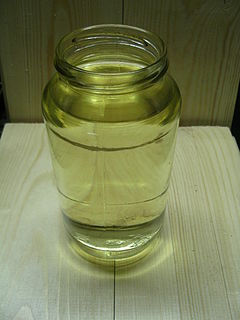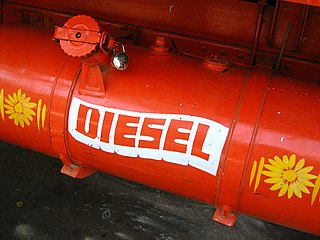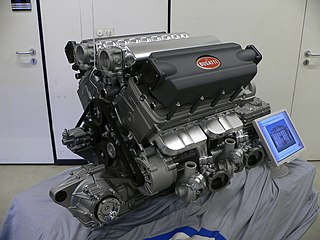
The compression ratio is the ratio between the volume of the cylinder and combustion chamber in an internal combustion engine at their maximum and minimum values.
Kerosene, paraffin, or lamp oil is a combustible hydrocarbon liquid which is derived from petroleum. It is widely used as a fuel in aviation as well as households. Its name derives from Greek: κηρός (keros) meaning "wax", and was registered as a trademark by Canadian geologist and inventor Abraham Gesner in 1854 before evolving into a generic trademark. It is sometimes spelled kerosine in scientific and industrial usage. The term kerosene is common in much of Argentina, Australia, Canada, India, New Zealand, Nigeria, and the United States, while the term paraffin is used in Chile, eastern Africa, South Africa, Norway, and in the United Kingdom. The term lamp oil, or the equivalent in the local languages, is common in the majority of Asia and the Southeastern United States. Liquid paraffin is a more viscous and highly refined product which is used as a laxative. Paraffin wax is a waxy solid extracted from petroleum.

Gasoline or petrol is a transparent, petroleum-derived flammable liquid that is used primarily as a fuel in most spark-ignited internal combustion engines. It consists mostly of organic compounds obtained by the fractional distillation of petroleum, enhanced with a variety of additives. On average, a 160-liter (42-U.S.-gallon) barrel of crude oil can yield up to about 72 liters of gasoline after processing in an oil refinery, depending on the crude oil assay and on what other refined products are also extracted. The characteristic of a particular gasoline blend to resist igniting too early is measured by its octane rating, which is produced in several grades. Tetraethyl lead and other lead compounds, once widely used to increase octane ratings, are no longer used except in aviation and off-road and auto-racing applications. Other chemicals are frequently added to gasoline to improve chemical stability and performance characteristics, control corrosiveness, and provide fuel system cleaning. Gasoline may contain oxygen-containing chemicals such as ethanol, MTBE, or ETBE to improve combustion.

Diesel fuel in general is any liquid fuel specifically designed for use in diesel engines, in which fuel ignition takes place, without any spark, as a result of compression of the inlet air mixture and then injection of fuel. Therefore, diesel fuel needs good compression ignition characteristics.
An octane rating, or octane number, is a standard measure of a fuel's ability to withstand compression in an internal combustion engine without detonating. The higher the octane number, the more compression the fuel can withstand before detonating. Octane rating does not relate directly to the power output or the energy content of the fuel per unit mass or volume, but simply indicates gasoline's capability against compression. In broad terms, fuels with a higher octane rating are used in higher-compression gasoline engines, which may yield higher power. Such higher power comes from the fuel's higher compression by the engine design, and not directly from the gasoline.
A stratified charge engine describes a certain type of internal combustion engine, usually spark ignition (SI) engine that can be used in trucks, automobiles, portable and stationary equipment. The term "stratified charge" refers to the working fluids and fuel vapors entering the cylinder. Usually the fuel is injected into the cylinder or enters as a fuel rich vapor where a spark or other means are used to initiate ignition where the fuel rich zone interacts with the air to promote complete combustion. A stratified charge can allow for slightly higher compression ratios without "knock," and leaner air/fuel ratio than in conventional internal combustion engines.

A petrol engine or gasoline engine is an internal combustion engine with spark-ignition, designed to run on petrol (gasoline) and similar volatile fuels.
Natural-gas condensate, also called natural gas liquids, is a low-density mixture of hydrocarbon liquids that are present as gaseous components in the raw natural gas produced from many natural gas fields. Some gas species within the raw natural gas will condense to a liquid state if the temperature is reduced to below the hydrocarbon dew point temperature at a set pressure.

Liquid fuels are combustible or energy-generating molecules that can be harnessed to create mechanical energy, usually producing kinetic energy; they also must take the shape of their container. It is the fumes of liquid fuels that are flammable instead of the fluid. Most liquid fuels in widespread use are derived from fossil fuels; however, there are several types, such as hydrogen fuel, ethanol, and biodiesel, which are also categorized as a liquid fuel. Many liquid fuels play a primary role in transportation and the economy.

Herbert Akroyd-Stuart was an English inventor who is noted for his invention of the hot bulb engine, or heavy oil engine.

The Ferguson TE20 is an agricultural tractor designed by Harry Ferguson. By far his most successful design, it was manufactured from 1946 until 1956, and was commonly known as the Little Grey Fergie. It marked a major advance in tractor design, distinguished by lightweight, small size, manoeuvrability and versatility. The TE20 popularised Harry Ferguson's invention of the hydraulic three-point hitch system around the world, and the system quickly became an international standard for tractors of all makes and sizes that has remained to this day. The tractor played a large part in introducing widespread mechanised agriculture. In many parts of the world the TE20 was the first tractor to be affordable to the average farmer and was small and light enough to replace the draft horse and manual labour. Many TE20s remain in regular use in farming and other work and the model is also a popular collector's item for enthusiasts today.

The hot-bulb engine is a type of internal combustion engine in which fuel ignites by coming in contact with a red-hot metal surface inside a bulb, followed by the introduction of air (oxygen) compressed into the hot-bulb chamber by the rising piston. There is some ignition when the fuel is introduced, but it quickly uses up the available oxygen in the bulb. Vigorous ignition takes place only when sufficient oxygen is supplied to the hot-bulb chamber on the compression stroke of the engine.
A petcock is a small shut-off valve used to control the flow of liquid or gas. Historically, petcocks were threaded valves controlled by a butterfly handle; modern petcocks are typically ball valves.
Engine efficiency of thermal engines is the relationship between the total energy contained in the fuel, and the amount of energy used to perform useful work. There are two classifications of thermal engines-
- Internal combustion and
- External combustion engines.

The Standard wet liner inline-four engine was a 2,088 cc inline four cylinder petrol engine produced by the Standard Motor Company. Originally developed concurrently for passenger car use and for the Ferguson TE20 tractor, it was widely used for Standard passenger cars of the 1950s, most notably the Vanguard. Later it was successfully used in Standard's popular early generation Triumph TR series sports cars.

Petroleum refining processes are the chemical engineering processes and other facilities used in petroleum refineries to transform crude oil into useful products such as liquefied petroleum gas (LPG), gasoline or petrol, kerosene, jet fuel, diesel oil and fuel oils.

A petrol-paraffin engine, TVO engine or gasoline-kerosene engine is an old-fashioned type of dual-fuel internal combustion engine with spark-ignition, designed to start on petrol (gasoline) and then to switch to run on paraffin (kerosene) once the engine is warm. The grade of paraffin used is known as tractor vaporising oil in the UK.
Distillate fuel, also called tractor fuel, was a petroleum product that was commonly used to power North American agricultural tractors in the early and mid-twentieth century. The product was crudely refined, akin to kerosene chemically, but impure.










